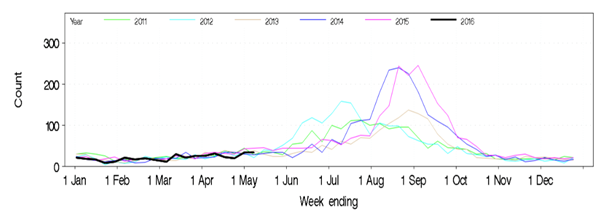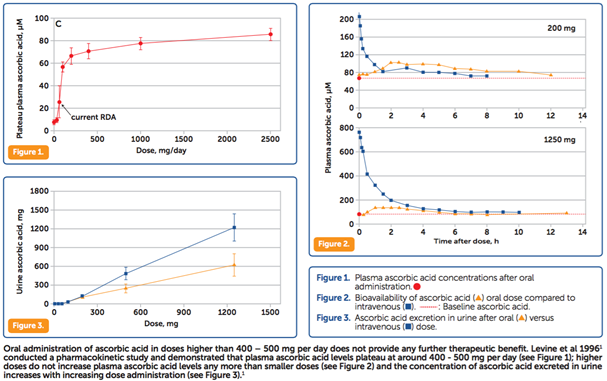
This year seems to be yet another bad season for colds and flu. More people seem to be reporting that they have been hit with a viral infection and are struggling to recover. The bad news is that we still haven’t reached the peak of the influenza season. We all have our trusted remedies to take when we get a viral illness. There are some other effective remedies that you may want to consider.

Heading into August and September, we see a seasonal peak in respiratory illnesses. Epidemiological reports show that in New South Wales the incidence of respiratory illness during winter has undergone a 3-fold increase (see graph above) over the past four years, with a remarkable spike in the number of reported cases in 2014 and 2015.
Acute respiratory infections are extremely common and are often not successfully treated using antibiotics, meaning that the best defense is a healthy immune system, as well as a strategy to minimise the severity and duration of cold and flu symptoms. Last year, the incidence of reported influenza, pneumonia and acute respiratory illness more than doubled compared to 2014. With the high flu-risk period fast approaching, investing in some immune support supplements is a wise choice.
Some of the trusted supplements we have used over the years include:
Vitamin C
Ascorbic acid is a water-soluble vitamin essential for a healthy immune system and can only be obtained from the diet due to the body’s inability to synthesize it. Optimum bioavailability of ascorbic acid occurs between 200 and 500 mg per day and as the oral dosage increases, bioavailability decreases and excess ascorbic acid is excreted in urine. Plasma ascorbic acid levels plateau at a dose between 500 and 1000 mg and does not increase with increasing doses (see Figure 1). Ascorbic acid bioavailability in plasma is near 100% at a single dose of 200 mg but at higher oral vitamin C doses, bioavailability declines significantly with a 1250 mg dose resulting in less than 50% bioavailability (see Figure 2). As the oral dose of ascorbic acid increases so does its excretion in urine (see Figure 3). Elevated doses may have adverse consequences as a 1000 mg dose has been shown to elevate urine uric acid and oxalate levels.
The prophylactic use of ascorbic acid can reduce the incidence, duration and severity of the common cold. 500mg doses taken every 3 to 4 hours over a day should be sufficient.

Zinc
Zinc is a critical nutrient for immune function due to its role in supporting a range of immune reactions. Zinc is a vital component of many proteins, over 300 enzymes; and is regarded as a key nutrient in the support of the immune system. Zinc together with ascorbic acid is shown to produce additive effects in supporting immune function; and together have shown to be effective in reducing the severity and/or duration of the common cold.
Some other supplements to consider include:
Vitamin D
Vitamin D insufficiency is surprisingly common in sunny Australia, particularly in winter. In much of Australia the sun is too weak during winter, therefore even if you are outdoors a lot, you could still be low in vitamin D. A vitamin D supplement may be your best option for keeping your immune system strong. Studies conducted on healthy adults have found that those with lower levels of vitamin D were twice as likely to get the flu, compared to people with high levels of vitamin D. Optimal levels of vitamin D is now considered to be 100 nmol/L or above. Individuals with lower blood vitamin D levels are more susceptible to getting sick, and tend to have a more severe infection. Next time you have a blood test, make sure your doctor includes vitamin D. Many people are surprised to find how low their vitamin D levels actually are.
Glutathione
Glutathione is essential for optimal immune function. Glutathione is critical for the physiological role of ascorbic acid in white blood cell (WBC) anti-microbial activity. As a result of the recycling of ascorbic acid, the internal concentration of ascorbic acid within the WBC increases 10-fold, in which it functions to quench oxidants generated during phagocytosis of unwanted pathogens, like viruses.
Manuka Honey
Manuka honey has been used as a traditional anti-microbial therapy for the treatment of infection. Honey has well documented anti-bacterial activity, together with anti-viral and anti-fungal properties. The anti-inflammatory effects of Manuka honey are effective in assisting the recovery from the common cold; as well as treating symptoms of upper-respiratory tract infections.
Probiotics
The gastrointestinal commensal microbiota significantly influences the immune system in humans. A Cochrane Review published in 2011 examined clinical studies assessing live microorganism intervention in cold and flu treatment, and found that probiotic bacteria including various Lactobacillus and Bifidobacterium species were effective in reducing the symptoms of acute upper respiratory tract infections. Research has shown that consumption of probiotics containing both Lactobacillus paracasei and Bifidobacterium lactis increases the antigen-specific immune response (IgG and sIgA) of patients to various viruses, further supporting their immune modulatory effects. In a 2014 systematic review it was determined that the use of probiotics in children is effective in diminishing the incidence and the severity of the symptoms of upper respiratory tract infections.
Arabinogalactan
Arabinogalactans are highly branched, water-soluble polysaccharides that are found in a wide variety of plants. Arabinogalactans specifically from the Larch tree are an excellent dietary fiber supplement, which is capable of increasing the commensal microbiota in the gut. Larch arabinogalactan has been shown to be effective against infection to the common cold virus. A number of human clinical studies using a proprietary arabinogalactan extract [ResistAid] from Larch (Larix laricina) have demonstrated arabinogalactan’s immunomodulatory activity, including a study which demonstrated a daily dose of 4.5 g significantly increased IgG antibody response of healthy volunteers to the pneumococcal vaccine when compared to placebo. In a more recent study it was demonstrated that arabinogalactan at a dose of 1.5 g daily significantly increased the IgG antibody response to tetanus vaccine compared to placebo. Larch arabinogalactans have also been shown to decrease the incidence of upper respiratory tract infections.
The scientific evidence supporting these immune-modulatory nutrients and probiotics provides a plausible therapeutic application for prophylactic and symptomatic treatment of upper respiratory tract infections in both children and adults.
References
- Department of Health. (2015). Australian influenza surveillance report no. 10 – 26 September to 09 October 2015.
- NSW Ministry of Health. (2016). NSW health influenza surveillance report week 19: 9 to 15 May 2016.
- Levine M, Conry-Cantilena C, Wang Y, et al. Vitamin C pharmacokinetics in healthy volunteers: evidence for a recommended dietary allowance. PNAS 1996; 93:3704-3709.
- Johnston C, Meyer S, Srilakshmi JC. Vitamin C Elevates Red Blood Cell Glutathione in Healthy Adults. Am J Clin Nutr 1993; 58:103-105.
- Rink L, Haase H. Zinc homeostasis and immunity. Trends in Immu 2007; 28:1-4.
- Wellinghausen N, Kirchner H, Rink L. The immunobiology of zinc. Immunol Today 1997; 18:519-521.
- Wintergerst E, Maggini S, Hornig D. Immune-Enhancing Role of Vitamin C and Zinc and Effect on Clinical Conditions. An Nutr Metab 2006; 50:85-94.
- Newall AT, et al. Influenza-related hospitalisation and death in Australians aged 50 years and older. Vaccine 2008;26(17):2135-41.
- Sabetta JR, DePetrillo P, Cipriani RJ, et al. Serum 25-hydroxyvitamin d and the incidence of acute viral respiratory tract infections in healthy adults. PLoS One 2010;5:6.
- Richie R, Nichenametla S, et al. Randomized Controlled Trial of Oral Glutathione Supplementation on Body Stores of Glutathione. Eur J Clin Nutr 2015; 54:251-263.
- Israili Z. Antimicrobial Properties of Honey. Am J Therapeu 2014; 21:304–323.
- Eteraf-Oskouei T, Najafi M. Traditional and Modern Uses of Natural Honey in Human Diseases: A Review. Iran J Basic Med Sci 2013; 16:731–742.
- Leong A, Herst P, Harper J. Indigenous New Zealand honeys exhibit multiple anti-inflammatory activities. Innate Immunol 2011-2012; 18:459-466.
- Hao, Qiukui et al, ‘Probiotics for Preventing Acute Upper Respiratory Tract Infections’ (2011) Cochr Database Syst Rev
- Rizzardini, Giuliano et al, ‘Evaluation of the Immune Benefits of Two Probiotic Strains Bifidobacterium Animalis Ssp. Lactis, BB-12® and Lactobacillus Paracasei Ssp. Paracasei, L. Casei 431® in an Influenza Vaccination Model: A Randomised, Double-Blind, Placebo-Controlled Study’ (2012) 107 The Brit J Nutr
- Ozen, Metehan, Gonca Kocabas Sandal and Ener Cagri Dinleyici, ‘Probiotics for the Prevention of Pediatric Upper Respiratory Tract Infections: A Systematic Review’ (2015) 15 Exp Opin Biol Ther
- Riede, L., B. Grube and J. Gruenwald, ‘Larch Arabinogalactan Effects on Reducing Incidence of Upper Respiratory Infections’ (2013) 29 Current Medical Res & Opin
- Udani, Jay K. et al, ‘Proprietary Arabinogalactan Extract Increases Antibody Response to the Pneumonia Vaccine: A Randomized, Double-Blind, Placebo-Controlled, Pilot Study in Healthy Volunteers’ (2010) 9 Nutri Journ
- Riede, L., B. Grube and J. Gruenwald, ‘Larch Arabinogalactan Effects on Reducing Incidence of Upper Respiratory Infections’ (2013) 29 Cur Med Res Opinion



